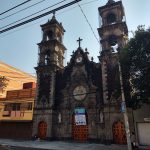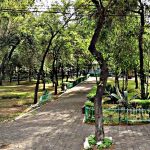
The Secretaría de Comunicaciones y Transportes/Centro SCOP complex stands as one of the most important 20th-century ruins in Mexico City. On its own merits, an uninhabitable and dangerous derelict is reason enough to fly to the Mexican capital. It’s a fenced-off area along Eje Central, and for that, it’s also the frequent subject of inquiries and questions.
Dramatic, even awe-inspiring, nearly the entire complex is off-limits. Closed to the public. The historic buildings opened in 1952. The heirs to the old Palace of Communications, today’s MUNAL, the Federal Department of Communications and Transportation was a modern day palace complex. More than that, it was a shining tribute to Modernism itself. The complex consisted of a 10-story tower, open lawns, a nursery, and housing units.
It lasted until just 1985. The two days of earthquakes collapsed most of the upper floors. Too beautiful to demolish, a masterpiece of the Mid-Century, the buildings have hung in limbo for the 35 years down to today.
The complex was the work of architect Carlos Lazo Barreiro. The General Manager of the Ciudad Universitaria construction project, he’d already been deeply involved in the most important university project in Latin America in his time. Researcher Marisol Martínez points out that he intended the SCOP Center to be an extension of that same project.
To that end, he enlisted artists to create some 6,000 square meters of murals. Their work took 18 months to complete. Juan O’Gorman may be merely the most prominent among them. José Chávez Morado, Francisco Zúñiga, and Rodrigo Arenas Betancourt together with O’Gorman produced 14 murals in that short time. Lazo’s early death at 41 in 1955 was but the first tragedy.
The murals remain remarkable. Thematically they’re dedicated to the work of the Federal Department. But indigenous iconography prevails. Even today, they’re legible and poignant. And the murals make the SCOP Center into nearly a pilgrimage center, at least for those interested in the Mid-20th Century and the Modernist works produced then.
Efforts begun after the 2017 earthquakes have relocated some of them. The Fine Arts Institute is, at last, overseeing everything. Current plans include painstakingly restoring all of them. They’ll remain a tribute to the abandoned site and to a past idea of the future they once envisioned.
Marisol Martínez, 3 September 2021, Local.mx: La historia de la actual Secretaría de Comunicaciones y Transportes, un monumento a la perpetuidad https://local.mx/ciudad-de-mexico/arquitectura/secretaria-comunicaciones-transportes-historia/
 +52 (55) 5723 9300
+52 (55) 5723 9300

Nearest at 0.44 kms.

Nearest at 0.56 kms.

Nearest at 0.63 kms.



One of Mexico City's oldest continuously inhabited little towns . . .

A sublime Italian Renaissance style has greeted passersby for nearly 120 years. Here's what it's about.

An incredible 3D rendering of one of the biggest cities in the hemisphere.

One of the popular public markets on Eje Central.

One of the Garibaldi area's strongest artistic clearinghouses.